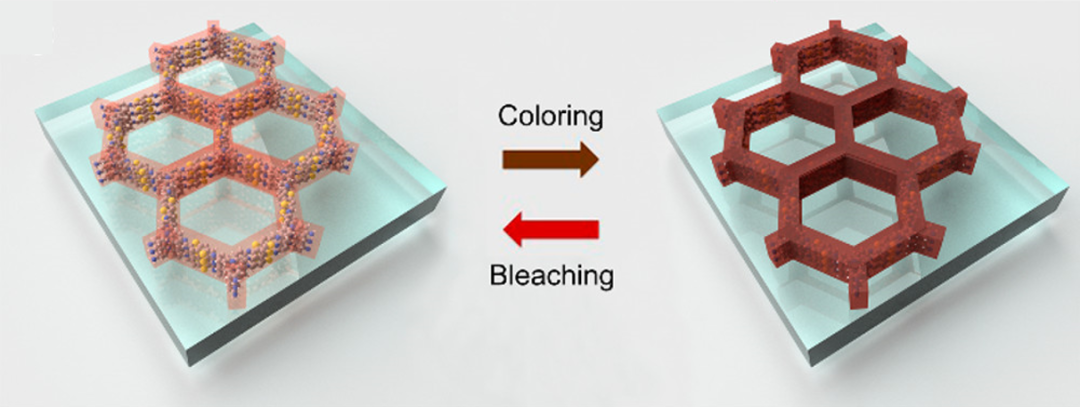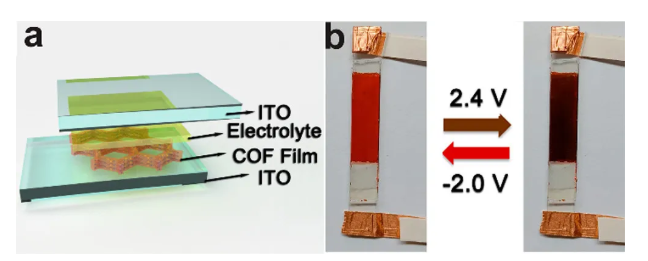
hotline:
17715390137
Tel/Wechat:
18101240246 (Technology)
0512-68565571
Email:mxenes@163.com (Sales Engineer)bkxc.bonnie@gmail.com
Scan the code to follow or search the official account on WeChat:
2D Materials Fronrier After paying attention,
click on the lower right corner to contact us,
Enter enterprise WeChat.
Professional Services Online

In 2019, Professor Wang Dong‘s group from the Institute of Chemistry of the Chinese Academy of Sciences, a JACS of Covalent Organic Framework (COF) films.

Figure 0 Header
Summary
The author used indium tin oxide (ITO) coated glass as a substrate to synthesize a two-dimensional COF film. The COF film has uniform morphology and good crystallinity, and its two-dimensional plane is parallel to the substrate; during the oxidation-reduction process, it exhibits a reversible color transition from deep red to deep brown. Spectroelectrochemical experiments found that during this process, the absorption spectra in the near-infrared and visible regions changed, and showed the characteristics of charge transfer between bids. The quasi-solid device prepared based on the COF film exhibits good electrochromic performance in the near infrared region.
introduction
COF powder and COF film have been used in many fields. Thanks to the fixed orientation of the pores and the extended π-π stacking structure, the oriented COF film has better application potential than non-oriented films in the electrochemical and photoelectrochemical fields.
The phenomenon of reversible color change of materials under external electrical stimulation is called electrochromism. Electrochromic materials have been widely used in fields such as smart windows, electronic displays, and information storage.
Generally, polymer electrochromic films are made by electrochemical polymerization or spin coating. Compared with one-dimensional polymers, the larger π-conjugated framework in the plane of the two-dimensional COFs, the π-π stacked structure formed between the planes, and the ordered micropores or mesopores are all conducive to ion transport and help To improve the electrochromic properties of the material.
In this paper, the author uses TAPA and TTDA as monomers, introduces ITO electrode as a substrate into the precursor solution, and directly synthesizes an oriented COF3PA-TT film on the ITO surface through a solid-liquid interface solvothermal method, as shown in Figure 1. And studied its electrochromic properties. The author observed that when the applied potential changes, COF3PA-TT exhibits a deep red-dark brown reversible color transition, as shown in Figure 2. Spectroelectrochemical experiments have confirmed that during this process, COF3PA-TT near infrared and visible light The zone absorption spectrum has changed. In addition, the quasi-solid device prepared based on the COF3PA-TT film has good electrochromic performance.

Figure 1 Synthesis of COF3PA-TT

Figure 2 Schematic diagram of electrochromic of oriented COF3PA-TT film on ITO electrode
Results and discussion
The synthesis of COF3PA-TT powder with high crystallinity has been reported (Nat. Chem. 2016, 8, 310-316). In the process of synthesizing the COF3PA-TT film in this article, in order to avoid the formation of powder, the author put the ITO electrode cut to the appropriate size into the glass tube vertically, and prepared the deep red COF3PA-TT film under the condition of low precursor concentration. .
In 2018, Yaghi‘s research group reported that there is a guest-regulated kinetic reconstruction phenomenon in COF based on urea bonds, which is caused by the flexibility of urea bonds (J. Am. Chem. Soc. 2018, 140, 16438-16441). In this paper, the large pores of COF3PA-TT and the non-planar structure of amine monomers may have similar effects. On the one hand, with the introduction and removal of guest molecules, the structure of COF3PA-TT powder changes. When the guest molecules are removed The structure cannot maintain the crystalline state; on the other hand, due to the good adhesion, the COF3PA-TT film directly grown on the ITO surface can maintain the pore structure perpendicular to the substrate under the support of the substrate.
The author used the ITO attached with the COF3PA-TT film directly as the working electrode, and tested its electrochemical and spectroelectrochemical behavior, as shown in Figure 3.

Figure 3 a) Cyclic voltammetry curve; b) Peak current change with scanning speed
c) Photographs of electrodes at 0 V and 1.4 V; d) Absorption spectra at 0 V and 1.4 V
e, f) Changes in absorption spectrum during oxidation
In order to evaluate the application potential of the electrode, the author used the electrode as the working electrode and blank ITO as the counter electrode. The polymer gel based on LiClO4 was injected between the electrodes as the electrolyte to prepare a quasi-solid electrochromic device with a sandwich structure. The device exhibits a reversible dark red-dark brown color transition between -2 V and 2.4 V, as shown in Figure 4. Compared with a single electrode, the stability is increased, the coloring time is longer, and the coloring efficiency is improved. The author believes that, Suppressed side reactions in the gel electrolyte may contribute to this.

Figure 4 a) Device structure; b) Deep red-dark brown reversible color transition
Compared with inorganic porous materials and metal organic frameworks (MOFs), COF3PA-TT film has medium response time and performance, high coloring efficiency, and wide response in the near-infrared region; compared with triphenylamine-based conjugated polymer, COF3PA-TT film performance And the coloring efficiency is medium, and COF3PA-TT is only based on the simplest triphenylamine monomer, and there is huge room for improvement. Experiments have proved that due to the layered structure of two-dimensional COFs, COF films have better electroluminescence properties than amorphous films of the same composition.
This work is expected to promote the development of COFs in the application of stimulus-response materials.
This information is sourced from the Internet for academic exchange only. If there is any infringement, please contact us to delete it immediately.

| Reminder: Beijing Beike New Material Technology Co., Ltd. supplies products only for scientific research, not for humans |
| All rights reserved © 2019 beijing beike new material Technology Co., Ltd 京ICP备16054715-2号 |